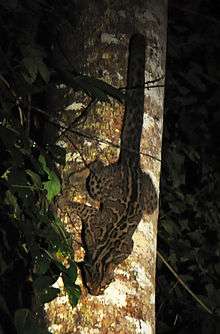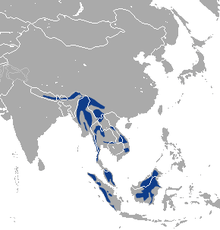Marbled cat
| Marbled cat | |
|---|---|
 | |
| A marbled cat in Danum Valley, Borneo | |
| Scientific classification | |
| Kingdom: | Animalia |
| Phylum: | Chordata |
| Class: | Mammalia |
| Order: | Carnivora |
| Suborder: | Feliformia |
| Family: | Felidae |
| Subfamily: | Felinae |
| Genus: | Pardofelis |
| Species: | P. marmorata[2] |
| Binomial name | |
| Pardofelis marmorata[2] (Martin, 1836) | |
| Subspecies | |
| |
 | |
| Marbled cat range | |
The marbled cat (Pardofelis marmorata) is a small wild cat of South and Southeast Asia, where it is suspected to occur over a large range. It is listed as Near Threatened on the IUCN Red List.[1]
The marbled cat was once considered to belong to the pantherine lineage of cats.[3] Genetic analysis has shown it to be closely related to the Asian golden cat and the bay cat, all of which diverged from other felids about 9.4 million years ago.[4]
Characteristics
The marbled cat is similar in size to a domestic cat, but has rounded ears and a very long tail that is as long as the cat's head and body. The ground colour of its long fur varies from brownish-grey to ochreous brown above and greyish to buff below. It is patterned with black stripes on the short and round head, on the neck and back. On the tail, limbs and underbelly it has solid spots. On the flanks it has irregular dark-edged blotches that fuse to dark areas and look like a 'marbled' pattern. Its paws are webbed between the digits and are completely sheathed.[5] Its coat is thick and soft. Spots on the forehead and crown merge into narrow longitudinal stripes on the neck, and irregular stripes on the back. The legs and underparts are patterned with black dots, and the tail is marked with black spots proximally and rings distally. It has large feet and unusually large canine teeth, resembling those of the big cats, although these appear to be the result of parallel evolution. Marbled cats range from 45 to 62 cm (18 to 24 in) in head-body length with a 35 to 55 cm (14 to 22 in) long and thickly furred tail that indicates the cat's adaptation to an arboreal lifestyle, where the tail is used as a counterbalance. Recorded weights vary between 2 and 5 kg (4.4 and 11.0 lb).[6]
Distribution and habitat
The marbled cat occurs along the eastern Himalayan foothills and in tropical Indomalaya eastward into southwest China, and on the islands of Sumatra and Borneo. It is primarily associated with moist and mixed deciduous-evergreen tropical forests. Its distribution in India is confined to the north-eastern forests.[1] In Borneo, it has also been recorded in peat swamp forest.[7]
In Bhutan, it has been recorded in Royal Manas National Park, and in broadleaved and mixed conifer forests at elevations up to 3,810 m (12,500 ft) in Jigme Dorji National Park and Wangchuck Centennial National Park.[8][9][10]
Two subspecies are recognized:[11]
- P. m. marmorata described by William Charles Linnaeus Martin in 1836[12] — lives in Malay Peninsula, Sumatra, Borneo northward to Myanmar
- P. m. charltoni described by John Edward Gray in 1846 — occurs in northern Myanmar, Sikkim, Darjeeling, and Nepal
The population size of the marbled cat is not well understood. Few records were obtained during camera-trapping surveys throughout much of its range. The only population density estimates stem from three areas in Sabah, Malaysian Borneo, and range from 7.1 to 19.6 individuals per 100 km2 (39 sq mi). The authors of this report cautioned that the density estimates from their study sites in Sabah may be higher than typically found elsewhere in the cat's range.[13]
Ecology and behaviour
In May 2000, a female marbled cat was trapped along an animal trail in a hill evergreen bamboo mixed forest in Thailand's Phu Khieu Wildlife Sanctuary. This first-ever radio-tracked marbled cat had an overall home range of 5.8 km2 (2.2 sq mi) at an elevation of 1,000 to 1,200 m (3,300 to 3,900 ft) and was active primarily during nocturnal and crepuscular time periods.[14]
Forest canopies probably provide the marbled cat with much of its prey: birds, squirrels and other rodents, and reptiles.[6] In the Bukit Barisan Selatan National Park, a marbled cat was observed in a dense forest patch in an area also used by siamang.[15] In Thailand, one individual has been observed in Phu Khieo Wildlife Sanctuary preying on a Phayre's leaf monkey.[16]
A few marbled cats have been bred in captivity, with gestation estimated to be 66 to 82 days. In the few recorded instances, two kittens were born in each litter, and weighed from 61 to 85 g (2.2 to 3.0 oz). Their eyes open at around 12 days, and the kittens begin to take solid food at two months, around the time that they begin actively climbing. Marbled cats reach sexual maturity at 21 or 22 months of age, and have lived for up to 12 years in captivity.[6]
Threats
Indiscriminate snaring is prevalent throughout much of its range, and likely poses a major threat. It is valued for its skin, meat, and bones, but infrequently observed in the illegal Asian wildlife trade.[1] During a survey in the Lower Subansiri District of Arunachal Pradesh, a marbled cat was encountered that had been killed by a local hunter for a festival celebrated by the indigenous Apatani community in March and April every year. The dead cat was used in a ceremony, and its blood was sacrificed to the deity for goodwill of their family and for ensuring a good harvest, protection from wildlife, disease and pest.[17] Deforestation is a further threat to the marbled cat.[1]
Conservation
Pardofelis marmorata is included in CITES Appendix I and protected over parts of its range. Hunting is prohibited in Bangladesh, Cambodia, Yunnan, India, Indonesia, Malaysia, Myanmar, Nepal, and Thailand. Hunting is regulated in Lao PDR and Singapore. In Bhutan and Brunei, the marbled cat is not legally protected outside protected areas. No information about protection status is available from Cambodia and Vietnam.[18]
References
- 1 2 3 4 5 Ross, J.; Brodie, J.; Cheyne, S.; Datta, A.; Hearn, A.; Loken, B.; Lynam, A.; McCarthy, J.; Phan, C.; Rasphone, A.; et al. (2016). "Pardofelis marmorata". The IUCN Red List of Threatened Species. IUCN. 2016: e.T16218A97164299. doi:10.2305/IUCN.UK.2016-1.RLTS.T16218A97164299.en. Retrieved 16 January 2018.
- 1 2 Wozencraft, W.C. (2005). "Felidae". In Wilson, D.E.; Reeder, D.M. Mammal Species of the World: A Taxonomic and Geographic Reference (3rd ed.). Johns Hopkins University Press. p. 542. ISBN 978-0-8018-8221-0. OCLC 62265494.
- ↑ Hemmer, H. (1978). "The evolutionary systematics of living Felidae: Present status and current problems". Carnivore. 1: 71–79.
- ↑ Johnson W. E., Eizirik E., Pecon-Slattery J., Murphy W. J., Antunes A., Teeling E., O'Brien S. J. (2006). "The late miocene radiation of modern Felidae: a genetic assessment". Science. 311: 73–77. doi:10.1126/science.1122277.
- ↑ Pocock, R. I. (1939). "Genus Pardofelis Severtzow". The Fauna of British India, including Ceylon and Burma. Mammalia – Volume 1. London: Taylor and Francis.
- 1 2 3 Sunquist, M.; Sunquist, F. (2002). "Marbled cat Pardofelis marmorata (Martin 1837)". Wild Cats of the World. Chicago: University of Chicago Press. pp. 373–376. ISBN 0-226-77999-8.
- ↑ Cheyne, S.M.; Macdonald, D.W. (2010). "Marbled cat in Sabangau peat-swamp forest, Indonesian Borneo" (PDF). Cat News. 52: 11.
- ↑ Tempa, T.; Hebblewhite, M.; Mills, L.S.; Wangchuk, T.R.; Norbu, N.; Wangchuk, T.; Nidup, T.; Dhendup, P.; Wangchuk, D.; Wangdi, Y. & Dorji, T. (2013). "Royal Manas National Park: A hotspot for wild felids, Bhutan". Oryx. 47 (2): 207–210. doi:10.1017/s0030605312001317.
- ↑ Thinley, P.; Morreale, S.J.; Curtis, P.D.; Lassoie, J.P.; Dorji, T.; Phuntsho, S. & Dorji, N. (2015). "Diversity, occupancy, and spatio-temporal occurrences of mammalian predators in Bhutan's Jigme Dorji National Park". Bhutan Journal of Natural Resources & Development. 2 (1): 19–27.
- ↑ Dhendup, T. (2016). "Notes on the occurrence of Marbled Cats at high altitudes in Bhutan" (PDF). NeBIO. 7 (2): 35–37.
- ↑ Pocock, R.I. (1939). The fauna of British India, including Ceylon and Burma. Mammalia. – Volume 1. Taylor and Francis, London.
- ↑ Martin, W. C. (1836). November 8, 1836. (Felis marmorata). Proceedings of the Zoological Society of London. Part IV, No. XLVII: 107–108.
- ↑ Hearn, A. J.; Ross, J.; Bernard, H.; Bakar, S. A.; Hunter, Luke T. B.; Macdonald, D. W. (2016). "The First Estimates of Marbled Cat Pardofelis marmorata Population Density from Bornean Primary and Selectively Logged Forest". PLOS ONE. 11 (3): e0151046. doi:10.1371/journal.pone.0151046. ISSN 1932-6203. PMC 4805203. PMID 27007219.
- ↑ Grassman, L. I. Jr.; Tewes, M. E. (2000). "Marbled cat in northeastern Thailand". Cat News. 33: 24.
- ↑ Morino, L. (2009). Observation of a wild marbled cat in Sumatra. Cat News 50: 20.
- ↑ Borries, C.; Primeau, Z.M.; Ossi-Lupo, K.; Dtubpraserit, S. & Koenig, A. (2014). "Possible predation attempt by a marbled cat on a juvenile Phayre's leaf monkey". Raffles Bulletin of Zoology (62): 561–565.
- ↑ Selvan, K.M., G.V. Gopi, B. Habib and S. Lyngdoh (2013). Hunting record of endangered Marbled Cat Pardofelis marmorata in the Ziro Valley of Lower Subansiri, Arunachal Pradesh, India. Journal of Threatened Taxa 5(1): 3583–3584.
- ↑ Nowell, K. and Jackson, P. (1996). Marbled Cat Felis marmorata. in: Wild Cats. Status Survey and Conservation Action Plan. IUCN/SSC Cat Specialist Group, Gland, Switzerland and Cambridge, UK.
External links
| Wikispecies has information related to Pardofelis marmorata |
| Wikimedia Commons has media related to Pardofelis marmorata. |
